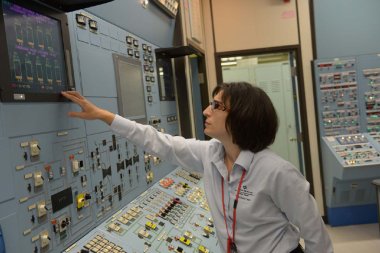Next level for Point Lepreau
30 August 2012
After four years out of service, New Brunswick Power's Point Lepreau nuclear power plant is entering the final phases of its restart program with regulatory approval to increase power up to 35%.
 |
Monitoring plant equipment from the Point Lepreau control room
(Image: NB Power) |
The Canadian Nuclear Safety Commission (CNSC) decision to allow the plant to operate above 0.1% of full power will enable further testing and inspections as the unit is recommissioned following refurbishment. The plant will not produce electricity at this stage of the process.
NB Power Nuclear site vice president Paul Pasquet explained that the operator is working through a series of tests and verifications of reactor components and plant systems. At the same time, reactor power is gradually being increased to pre-determined levels as the team progresses throughout the final restart phases. This will include running up the turbines and synchronizing the generator to the electricity grid.
Further regulatory approval will be needed before reactor power can be increased above 35%. Before that approval is granted, station staff will carry out a planned shutdown to remove specialized equipment used to start up reactors with new fuel as part of the testing and commissioning process. The planned shutdown will also provide an opportunity to carry out any adjustments or maintenance that may arise during turbine run up and testing.
Regulatory approval to restart the reactor at low power (up to 0.1%) was granted in July. CNSC executive vice-president and chief regulatory operations officer Ramzi Jammal said that NB Power Nuclear had now completed all the required tests for the authorization to increase power above 0.1%. He noted that the CNSC would be continuing to monitor restart activities at the plant.
The single-unit 680 MWe pressurized heavy-water plant, which began commercial operation in 1983, is the first Candu 6 to undergo full refurbishment. It was taken offline in March 2008 for major refurbishment including the replacement of all 380 fuel channels, calandria tubes and feeder tubes, work which was originally expected to be completed in 16 months. The program was set back when problems with seal tightness necessitated the removal and replacement of all the calandria tubes for a second time.
Researched and written
by World Nuclear News